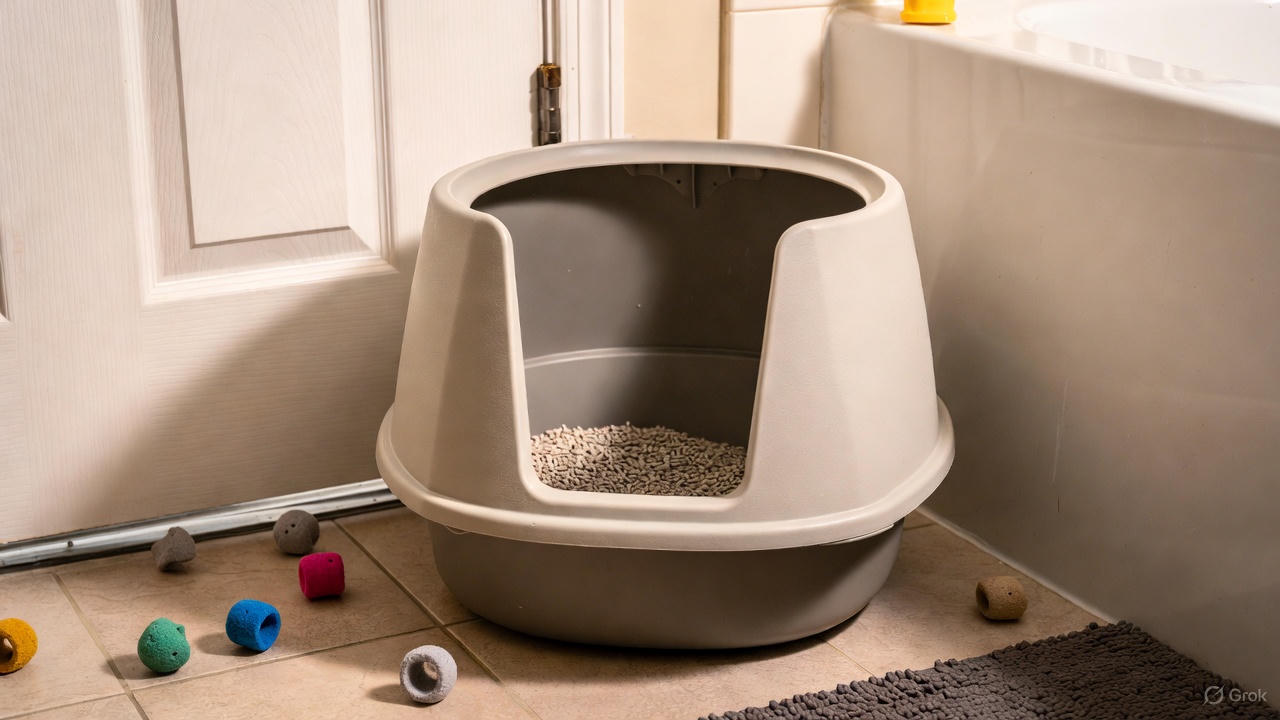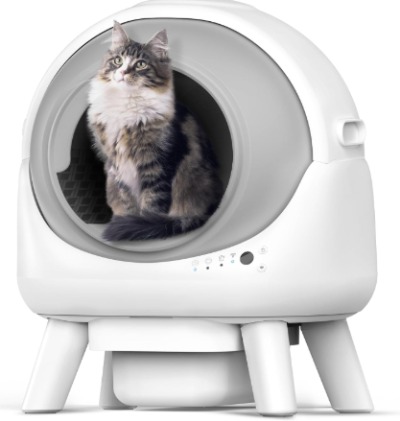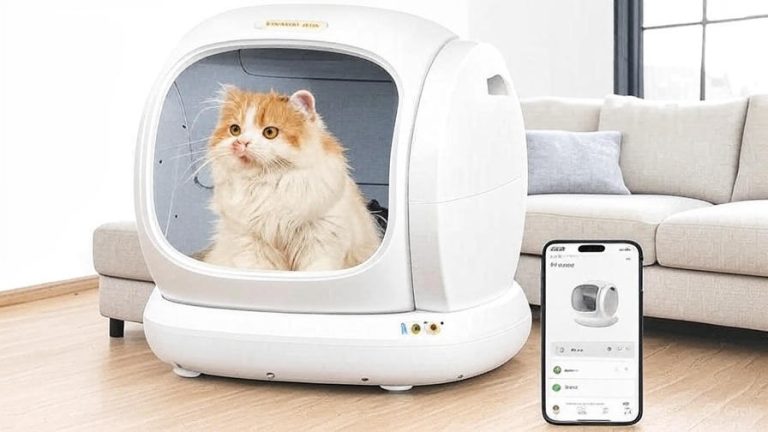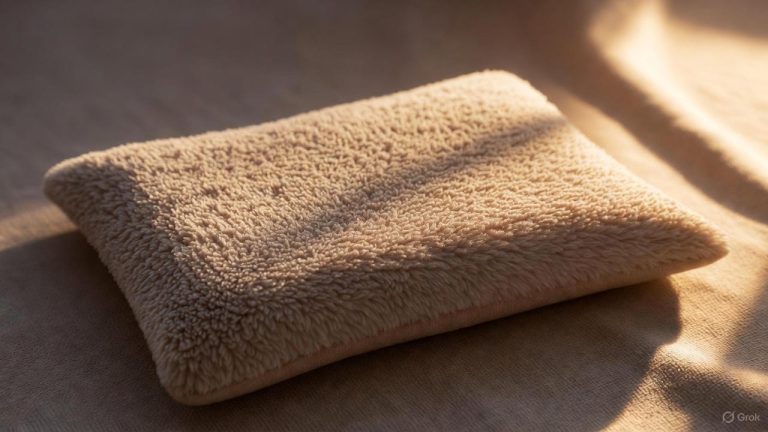5 Best Litter Box for Vertical Peeing Cats In 2025
Cats can be peculiar creatures, and some develop a habit that catches many owners off guard: vertical peeing. This behavior means your feline friend sprays or urinates while standing upright against the walls of their litter box. The result? Messy cleanup sessions and constant frustration as urine seeps outside the box and onto your floors.
High-sided litter boxes solve this common problem by containing spray and preventing leaks. These specialized designs feature tall walls that catch vertical streams before they escape. Whether your cat naturally stands while eliminating or has developed this habit over time, the right litter box makes all the difference between daily cleanup disasters and hassle-free maintenance.
This guide examines five top-performing litter boxes designed specifically for cats who pee vertically. Each option brings unique features to address the challenges of high-spraying cats while maintaining odor control and easy cleaning. We tested these products extensively to help you find the perfect solution for your home.
Understanding Vertical Peeing in Cats
Before diving into product reviews, it helps to know why cats develop this behavior. Some felines simply prefer standing while urinating due to their anatomy or personal preference. Others may spray vertically as a marking behavior, especially if they’re unneutered males or females in heat. Medical conditions like urinary tract infections can also cause unusual bathroom habits.
Older cats with arthritis might find it uncomfortable to squat, leading them to eliminate while standing. Stress and anxiety trigger vertical spraying in many cats as well. Regardless of the cause, you need a litter box with walls tall enough to contain the spray pattern.
Standard litter boxes typically feature walls between 4-6 inches high. These shallow designs work fine for cats who squat normally but fail miserably with vertical peeers. The urine shoots over the edge and creates puddles around your bathroom or laundry room. High-sided and enclosed designs prevent this issue by adding extra height and coverage.
Key Features to Look For
When shopping for a litter box for vertical peeing cats, certain features matter more than others. Wall height ranks as the most critical factor. Look for designs with sides measuring at least 10-12 inches tall, though some cats need even taller barriers. Enclosed models with lids offer maximum protection against spray escape.
Material quality affects both durability and odor resistance. Stainless steel boxes resist odors better than plastic and won’t absorb urine smells over time. They also last longer and clean more easily. However, quality plastic options still work well if you’re on a budget.
Entry point design deserves consideration too. Top-entry boxes force cats to jump in from above, which contains litter scatter but may not suit elderly or disabled cats. Front-entry models with high sides work better for cats with mobility issues. Some designs feature removable tops or flip lids that give you access flexibility.
Size matters tremendously for vertical peeers. Your cat needs enough room to turn around comfortably inside the box. Cramped quarters lead to poor aim and more messes. Extra-large options accommodate bigger breeds and multiple cats while giving ample space for movement.
Odor control features keep your home smelling fresh. Built-in filters, sealed lids, and non-porous materials all help trap unpleasant smells. Stainless steel naturally resists bacterial growth that causes odors. Some models include activated charcoal filters in their lids to absorb ammonia scents.
Top 5 Litter Boxes for Vertical Peeing Cats
1. Citylife Stainless Steel Cat Litter Box with Lid – Best Overall
The Citylife XL represents the gold standard for managing vertical peeing cats. This extra-large enclosed design combines premium stainless steel construction with thoughtful features that address every aspect of spray containment.
Product Description
This enclosed litter box measures generously to accommodate cats of all sizes, including large breeds like Maine Coons. The dark grey stainless steel body resists rust and corrosion while maintaining a sleek appearance that blends with modern home decor. The removable lid creates a fully enclosed environment that traps both spray and odors.
The package includes a metal litter scoop and double-layer litter mat. The mat catches tracked litter as your cat exits, keeping your floors cleaner. The non-stick interior surface wipes clean in seconds without absorbing odors. The metal construction eliminates the plastic smell that bothers some sensitive cats.
Pros
The stainless steel material stands out as the biggest advantage. Unlike plastic boxes that develop permanent urine odors, this metal design wipes completely clean. The surface never retains smells, even after repeated use. This feature alone justifies the higher price point for many cat owners.
Height and coverage provide excellent spray containment. The high walls combined with the lid create an enclosed space that captures vertical streams from any angle. Cats can spray as high as they want without making messes outside the box.
Cleaning takes minimal effort thanks to the non-stick surface. You simply wipe the interior with a damp cloth and mild soap. No scrubbing required. The stainless steel doesn’t scratch easily, so it maintains its smooth finish over time.
The included accessories add value. The metal scoop lasts longer than plastic versions and cleans more thoroughly. The double-layer mat effectively captures litter granules, reducing tracking throughout your home.
Large cats fit comfortably inside without feeling cramped. The spacious interior gives them room to turn around and position themselves naturally. This reduces the chance of accidental misses.
Cons
The price point sits higher than plastic alternatives. Budget-conscious shoppers might hesitate at the initial investment, though the durability offsets the cost over time.
Weight makes this box less portable than plastic options. Moving it for cleaning or relocation requires more effort. However, most cat owners place their litter boxes in permanent spots anyway.
The metal can feel cold, which some cats dislike during winter. Placing the box in a warm area or adding extra litter helps address this issue.
Assembly requires following the instructions carefully. Some users report confusion with the lid attachment initially, though it becomes simple after the first setup.
Who Should Buy This
Cat owners dealing with persistent vertical peeing problems will appreciate this box’s comprehensive solution. The combination of height, enclosure, and odor-resistant material tackles the issue from every angle.
Households with large breed cats benefit from the extra-large size. The spacious interior accommodates big-bodied felines comfortably. Multi-cat homes can use this as a primary box that handles heavy use.
Anyone tired of replacing plastic boxes every few years should invest in this durable option. The stainless steel construction essentially lasts forever with proper care. You’ll stop spending money on replacement boxes.
2. Topyangs Black Stainless Steel Litter Box with Lid – Best Design Innovation
Topyangs brings creative engineering to the vertical peeing problem with their 135-degree flip-top design. This unique opening mechanism sets it apart from traditional enclosed boxes.
Product Description
The black stainless steel construction gives this box a sophisticated appearance that looks more like furniture than a pet accessory. The flip-top lid opens at a 135-degree angle, creating a wide entry point that stays open hands-free during cleaning. This design eliminates the hassle of completely removing lids.
The high sides extend well above standard heights to contain spray effectively. The breeze system design promotes air circulation while maintaining odor control. The covered structure with anti-spill edges prevents litter scatter in all directions.
Pros
The flip-top mechanism revolutionizes the cleaning process. Instead of removing the entire lid and finding somewhere to set it, you simply flip it back and secure it in the open position. Both hands stay free to scoop and maintain the box. This feature saves time and frustration during daily maintenance.
Black stainless steel offers the same odor resistance benefits as other metal options while providing a distinctive look. The dark finish hides discoloration better than lighter colors. It matches well with modern bathrooms and laundry rooms.
High sides combined with the covered top create maximum spray protection. Even determined vertical peeers can’t shoot urine outside this enclosed space. The anti-spill rim adds an extra barrier against accidents.
The breeze system allows fresh air to circulate without letting odors escape. This balance keeps the interior from becoming stuffy while still controlling smells. Your cat gets better air quality inside the box.
Cats who dislike fully enclosed spaces adapt better to this design. The flip-top creates a more open feeling than completely sealed boxes. Anxious cats feel less trapped while still getting privacy.
Cons
The flip mechanism adds moving parts that could wear out over time. While built durably, hinges represent a potential failure point that solid one-piece lids don’t have.
The 135-degree opening, while convenient, takes up space behind the box. You need extra clearance for the lid to flip back fully. This limits placement options in tight spaces.
Some cats figure out how to flip the lid open themselves. Clever felines might treat it as a toy or exit route. The flip mechanism, while secure, isn’t lock-tight.
Price matches premium competitors despite the added complexity. Budget shoppers will find this expensive compared to basic enclosed plastic boxes.
Cleaning the hinge area requires extra attention. Litter dust can accumulate in the mechanism, requiring periodic detailed cleaning to maintain smooth operation.
Who Should Buy This
Cat owners who clean litter boxes multiple times daily will love the flip-top convenience. If you scoop frequently, the time saved adds up quickly. The hands-free design makes the chore less cumbersome.
People with limited mobility or strength appreciate not having to lift heavy lids. The flip mechanism requires minimal effort compared to removing solid tops. Elderly users or those with arthritis find this design more manageable.
Style-conscious pet owners who want their litter box to look attractive will appreciate the sleek black finish. This box looks intentional rather than like something you’re trying to hide.
3. Enclosed Stainless Steel Cat Litter Box with Modular Design – Best for Easy Maintenance
This modular design takes a different approach to vertical peeing management by incorporating a pull-out drawer system. The dark grey stainless steel construction combines durability with innovative functionality.
Product Description
The modular structure separates into distinct components that simplify maintenance. The bottom drawer slides out for quick waste removal without disturbing the entire box setup. The flip door entry gives cats easy access while maintaining the enclosed environment.
The extra-large size fits all cat breeds comfortably. The non-stick interior cleans effortlessly and never absorbs odors. The dark grey finish resists showing scratches and maintains its appearance over extended use.
Pros
The drawer system transforms the cleaning experience. Instead of tilting or moving the entire box to access the litter, you simply pull out the drawer. This feature particularly helps people with back problems or limited strength. You can clean without bending or lifting heavy boxes.
Odor control works exceptionally well with this enclosed design. The combination of the flip door entry and sealed structure traps smells effectively. The stainless steel naturally resists bacterial growth that causes ammonia odors.
The modular components separate completely for deep cleaning. When you need to wash the box thoroughly, each piece comes apart easily. This design ensures every surface gets cleaned properly, preventing buildup in hard-to-reach areas.
Non-stick interior coating makes waste removal effortless. Clumps slide right out without sticking. You spend less time scraping and more time doing activities you actually enjoy.
The flip door provides controlled entry that reduces litter tracking. Cats must step through deliberately rather than leaping out and scattering litter. This feature keeps surrounding areas tidier.
Cons
The drawer mechanism adds complexity that some users find unnecessary. If you prefer simple, straightforward designs, the modular system might feel overengineered.
Drawer seals require periodic checking. The connection between drawer and frame needs to stay tight to prevent leaks. Over time, wear can create gaps that allow urine to seep through.
Assembly takes longer than one-piece designs. You need to connect multiple components correctly during initial setup. The instructions must be followed precisely to ensure proper function.
The drawer adds height to the overall box. You need more vertical clearance space than with standard designs. This can limit placement options in areas with low ceilings or underneath furniture.
Cats who like to dig aggressively might shift the drawer if they’re particularly vigorous. While the mechanism locks in place, extremely active cats could potentially dislodge it during enthusiastic digging sessions.
Who Should Buy This
Pet owners with multiple cats benefit from the easy-access drawer system. Frequent cleaning becomes less of a chore when you can quickly pull out the drawer, scoop, and slide it back. High-traffic litter boxes need efficient maintenance systems.
People who struggle with mobility issues should consider this ergonomic design. The drawer eliminates bending and heavy lifting. You can maintain the box while standing comfortably.
Those who prioritize thorough cleaning will appreciate how completely the modular system breaks down. Every surface becomes accessible for periodic deep cleaning sessions.
4. ELS PET Self Cleaning Litter Box – Orbitie – Best Automatic Solution
The Orbitie represents cutting-edge technology applied to the vertical peeing problem. This automatic self-cleaning box removes human intervention from the daily maintenance equation.
Product Description
The Orbitie uses advanced sensors and rotating mechanisms to automatically separate waste from clean litter. The system detects when your cat exits and initiates a cleaning cycle after a brief delay. Waste gets deposited into a sealed drawer that you empty weekly rather than daily.
App connectivity lets you monitor usage patterns and cleaning cycles from your smartphone. The safety module includes multiple sensors that prevent operation if your cat returns to the box mid-cycle. The package includes a litter mat and supply of waste bags.
The design accommodates multiple cats through its large capacity and efficient cleaning system. The enclosed structure with high walls contains vertical spray while the automated cleaning maintains hygiene.
Pros
Automatic cleaning eliminates daily scooping. The system handles waste removal on its own, leaving you with minimal maintenance duties. This feature transforms life for busy cat owners who struggle to keep up with daily litter box chores.
App control provides valuable insights into your cat’s bathroom habits. You can track frequency, duration, and timing of litter box visits. These patterns help identify potential health issues early. The app also lets you customize cleaning cycles and receive maintenance reminders.
Multiple safety features protect curious cats. The sensors detect movement and stop operation instantly if a cat enters during a cleaning cycle. The safety module prevents accidents that could harm your pet.
High walls and enclosed design contain vertical spray effectively. The automatic nature doesn’t compromise the physical spray-containment features. You get both technological convenience and practical spray protection.
The sealed waste drawer controls odors better than traditional boxes. Waste gets isolated immediately after cleaning cycles. The enclosed nature prevents smells from escaping between disposal sessions.
Cons
The price point puts this option out of reach for many cat owners. Automatic litter boxes cost significantly more than even premium manual options. The investment makes sense only if you value the automation highly.
Mechanical components can malfunction. Motors, sensors, and moving parts represent potential failure points. While built reliably, electronic systems need eventual repairs or replacement.
Some cats fear the noise and movement. The rotating cleaning cycle produces sounds that startle nervous cats. Skittish felines might refuse to use the box during the adaptation period. Patient introduction helps, but some cats never adjust.
The system requires specific litter types. Clumping clay litters work best with the mechanism. Crystal litters, pellets, and other alternatives may not function properly. This limitation restricts your litter choices.
Power outages disable the automatic functions. You need electrical access wherever you place the box. Battery backup would improve reliability but isn’t included.
App dependency creates additional complexity. Setting up connectivity, maintaining app updates, and troubleshooting connection issues add steps to box management. Less tech-savvy users might find this frustrating.
Who Should Buy This
Busy professionals who travel frequently benefit most from automatic cleaning. If you work long hours or spend nights away from home, the Orbitie maintains hygiene in your absence. Your cat gets a consistently clean box without relying on pet sitters.
Tech enthusiasts who enjoy smart home devices will appreciate the app integration and automated features. If you already control your lights, thermostat, and security through apps, adding litter box monitoring fits naturally into your lifestyle.
Multi-cat households can justify the expense through sheer cleaning time saved. The more cats you have, the more valuable automatic cleaning becomes. Three or more cats using traditional boxes requires substantial daily effort.
People with disabilities or chronic conditions that make scooping difficult should consider this solution. The automation removes physical barriers to maintaining proper litter box hygiene.
5. Nature’s Miracle Hooded Flip Top Litter Box – Best Budget Option
Nature’s Miracle proves you don’t need to spend a fortune to manage vertical peeing cats. This plastic hooded design delivers essential features at an accessible price point.
Product Description
The hooded flip-top design creates an enclosed space with high walls that contain spray. The built-in odor control charcoal filter absorbs smells without requiring electronic systems or expensive materials. The flip-top lid provides easy access during cleaning while maintaining coverage during use.
The compact footprint fits in smaller bathrooms and laundry rooms. The neutral color blends with various decor styles. The plastic construction keeps weight manageable for moving and cleaning.
Pros
Affordability makes this box accessible to every cat owner. The low price point lets you try a high-sided enclosed design without major financial commitment. If your cat adapts well, you can upgrade to premium materials later.
The charcoal filter provides effective odor control despite the simple design. The replaceable filter absorbs ammonia smells naturally without power or complex systems. Replacement filters cost little and install quickly.
Lightweight plastic makes this box easy to move and clean. You can carry it to the bathtub or outdoor cleaning area without strain. Mobility helps maintain higher cleaning standards.
The flip-top design offers cleaning convenience similar to premium metal options. While the materials differ, the functional access works the same way. You get hands-free lid management at a fraction of the cost.
High walls successfully contain most vertical spraying. While not as tall as premium options, the height handles moderate spray patterns. Many cats who pee vertically don’t spray at maximum height consistently.
Assembly requires no tools or complex instructions. The pieces snap together intuitively. You can set up the box and have it ready for use within minutes.
Cons
Plastic absorbs odors over time. Even with regular cleaning, the material eventually retains urine smells permanently. You’ll need to replace the box every few years as odor control degrades.
Durability doesn’t match metal alternatives. Plastic scratches more easily and can crack if dropped. The material degrades from UV exposure if placed near windows. Expected lifespan measures in years rather than decades.
The charcoal filter needs regular replacement. While inexpensive, this creates ongoing maintenance costs and another supply to monitor. Forgetting to replace filters reduces odor control effectiveness.
Size limitations might not accommodate extra-large cats. The compact design saves space but sacrifices interior room. Big-bodied breeds might feel cramped and avoid using the box.
The plastic hood can feel flimsy compared to solid metal lids. Some cats learn to push it open or knock it loose. The connection between hood and base isn’t as secure as premium options.
Lower walls compared to premium boxes mean some high sprayers might exceed the containment. Cats who consistently spray at maximum height might still shoot over the top occasionally.
Who Should Buy This
First-time cat owners testing whether their cat needs a high-sided box should start here. The low investment lets you determine if your cat’s vertical peeing requires intervention. You can always upgrade after confirming the need.
Budget-conscious cat owners who need immediate solutions will appreciate the accessibility. If your finances are tight but your cat’s behavior demands action, this box provides essential features affordably.
People managing temporary situations like foster cats benefit from the disposable price point. You can provide proper containment without major investment in animals that won’t stay permanently.
Households with multiple litter box locations can mix this budget option with premium choices. Place expensive boxes in main areas and use these in secondary locations. This strategy balances cost with coverage.
Making the Right Choice for Your Cat
Selecting the perfect litter box depends on your specific situation. Start by observing your cat’s spray height and pattern. Some cats shoot urine straight up while others angle it toward walls. Measure the maximum height of their spray to determine minimum wall height requirements.
Consider your cat’s size and mobility. Large breeds need spacious interiors with generous turning room. Older cats with arthritis might struggle with high-entry designs, even if they pee vertically. Top-entry boxes challenge cats with joint problems.
Think about your cleaning preferences and physical capabilities. If you scoop multiple times daily, manual boxes with convenient access make sense. If you want minimal intervention, automatic options justify their cost. Modular designs with drawer systems help people with back problems or limited mobility.
Budget plays a significant role in the decision. Stainless steel boxes cost more initially but last longer and resist odors better. Plastic options save money upfront but require eventual replacement. Calculate the long-term cost rather than just the initial price.
Space availability influences box selection. Measure your intended location carefully, remembering that flip-top lids need clearance to open. Top-entry designs have taller profiles. Extra-large boxes won’t fit in tight corners.
The number of cats in your household affects capacity needs. Multiple cats using one box require frequent cleaning regardless of design. Automatic boxes handle multiple cats better than manual options. You might need several boxes if you have numerous cats.
Your tolerance for technology matters with automatic options. If troubleshooting apps and maintaining electronics frustrates you, stick with manual designs. Tech-comfortable users will enjoy smart features.
Tips for Successful Transition
Cats resist change, so introducing a new litter box requires strategy. Place the new box next to the old one initially. Let your cat explore it empty before adding litter. Cats prefer familiar scents, so mix some used litter from the old box into the new one.
Keep the old box available during the transition period. Some cats need days or weeks to accept new equipment. Forcing immediate change can lead to elimination problems outside the boxes. Patience prevents behavioral issues.
Maintain consistent litter type during transitions. Changing both box and litter simultaneously confuses cats. Introduce one variable at a time. Once your cat accepts the new box, you can experiment with different litter if desired.
Position the box in a quiet, accessible location. Cats avoid boxes placed near noisy appliances or high-traffic areas. They need privacy during elimination. Ensure your cat can reach the box easily from their favorite lounging spots.
Clean the box regularly regardless of type. Even automatic boxes need periodic deep cleaning. Cats abandon dirty boxes, which defeats the purpose of buying better equipment. Establish a maintenance routine and stick to it.
If your cat refuses the new box after two weeks, reassess your choice. The design might not suit their preferences. Some cats dislike enclosed spaces. Others fear flip-top mechanisms. Pay attention to their behavior and adjust accordingly.
Maintenance and Long-Term Care
Proper maintenance extends your litter box’s lifespan and keeps your cat happy. Scoop waste daily, even with automatic boxes. Empty waste compartments before they overflow. Full waste containers reduce effectiveness and create odor problems.
Deep clean the box weekly. Remove all litter and wash the interior with mild soap and warm water. Avoid harsh chemicals that leave strong scents. Cats have sensitive noses and might reject boxes that smell like cleaners. Rinse thoroughly and dry completely before refilling.
Check all components regularly. Inspect seals, hinges, and connections for wear. Tighten loose parts promptly. Replace damaged components before they fail completely. Preventive maintenance prevents bigger problems.
Replace filters on schedule. Charcoal filters lose effectiveness over time. Mark replacement dates on your calendar so you don’t forget. Fresh filters maintain optimal odor control.
Monitor for scratches and damage on plastic boxes. Scratches harbor bacteria and absorb odors. Once plastic develops deep scratches, odor removal becomes nearly impossible. Plan to replace plastic boxes when scratches accumulate.
Stainless steel boxes need minimal special care. The material resists damage and doesn’t absorb smells. However, harsh abrasives can scratch the finish. Use soft cloths and gentle cleaners to maintain the surface.
Automatic boxes require technical maintenance. Update apps when prompted. Clean sensors carefully to ensure proper detection. Lubricate moving parts according to manufacturer instructions. Keep the mechanical components free from litter dust.
Store replacement supplies conveniently. Keep extra waste bags, filters, and cleaning supplies near the litter box. Having everything accessible makes maintenance easier and more likely to happen consistently.
Health Benefits of Proper Litter Box Management
Using the right litter box for your vertical peeing cat does more than prevent messes. It protects both your cat’s health and your home’s hygiene. Cats who feel uncomfortable with their litter box might hold their urine too long, leading to urinary tract infections or bladder stones.
Proper containment prevents urine from soaking into your floors and baseboards. Urine damage causes expensive home repairs. The ammonia in cat urine creates health risks for humans too, especially in poorly ventilated spaces. Proper containment and odor control protect your family’s respiratory health.
Stress reduction comes from giving your cat a suitable bathroom space. Cats experience anxiety when their litter box feels inadequate. This stress manifests in various behavioral problems beyond elimination issues. A properly designed box helps your cat feel secure.
Monitoring becomes easier with the right equipment. You’ll notice changes in elimination patterns more quickly when waste gets contained properly. These observations help identify health problems early. App-connected boxes provide even more detailed tracking.
Environmental Considerations
Litter box choices impact environmental sustainability. Stainless steel boxes last decades, preventing plastic waste. While they cost more initially, they eliminate the need for repeated replacements. This durability reduces environmental impact over time.
Plastic boxes contribute to landfill waste when discarded. Most plastic litter boxes aren’t recyclable due to contamination. If you choose plastic, commit to using it as long as possible before replacement.
Some automatic boxes require disposable waste bags. Consider biodegradable options if available. The convenience of automation shouldn’t ignore environmental responsibility.
Litter type matters environmentally too. While not the focus of this article, consider pairing your eco-friendly box choice with sustainable litter options. Clay litters require strip mining. Plant-based alternatives offer better environmental profiles.
Common Mistakes to Avoid
Many cat owners make predictable errors when addressing vertical peeing. Don’t assume any high-sided box will work. Wall height must exceed your cat’s spray height with room to spare. Measure before buying rather than guessing.
Avoid placing the box in inconvenient locations just to hide it. Cats need easy access to their bathroom. Tucking the box in a remote corner might keep it out of sight but could lead to accidents elsewhere when your cat can’t reach it quickly.
Don’t neglect regular cleaning despite having an advanced box. No design eliminates the need for maintenance. Automatic boxes still need waste disposal and periodic deep cleaning. High walls don’t prevent odors if you ignore cleaning schedules.
Resist buying the cheapest option without considering quality. Extremely inexpensive boxes often fail quickly. Calculate the cost per year of use rather than just the purchase price. Sometimes spending more initially saves money long-term.
Don’t force your cat to use a box they dislike. If your cat consistently avoids the new box, investigate why. They might dislike the hood, fear the automatic mechanisms, or find the entry difficult. Respect their preferences rather than insisting they adapt.
Avoid mixing too many changes simultaneously. When transitioning to a new box, keep other variables constant. Don’t also switch litter brands, move the box location, and change cleaning routines all at once. Gradual changes work better.
Final Thoughts
Managing a cat who pees vertically challenges even experienced cat owners. The constant cleanup and lingering odors test your patience and dedication. However, the right litter box transforms this frustrating situation into a manageable routine.
High-sided and enclosed litter boxes contain spray effectively while maintaining your home’s cleanliness. Whether you invest in premium stainless steel construction or start with a budget-friendly plastic option, proper containment makes daily life with your cat more pleasant for everyone.
The five boxes reviewed here represent the best solutions currently available. The Citylife stainless steel option offers unmatched durability and odor resistance. The Topyangs flip-top design innovates convenient access. The modular drawer system simplifies maintenance. The Orbitie automates the entire process. Nature’s Miracle provides essential features affordably.
Your perfect choice depends on your cat’s specific needs, your budget, your living space, and your personal preferences. Consider all factors carefully before deciding. Remember that your cat’s comfort and your home’s cleanliness both matter. The right litter box achieves both goals simultaneously.
Vertical peeing doesn’t have to mean accepting permanent floor damage and constant odors. Modern litter box designs solve this problem effectively. Take control of the situation by choosing equipment that matches the challenge. Your cat will appreciate having a suitable bathroom space, and you’ll enjoy a cleaner, fresher-smelling home.
Invest in quality equipment, maintain it properly, and watch the vertical peeing problem become just another manageable aspect of cat ownership. The days of mopping urine puddles can end today with the right litter box choice.












